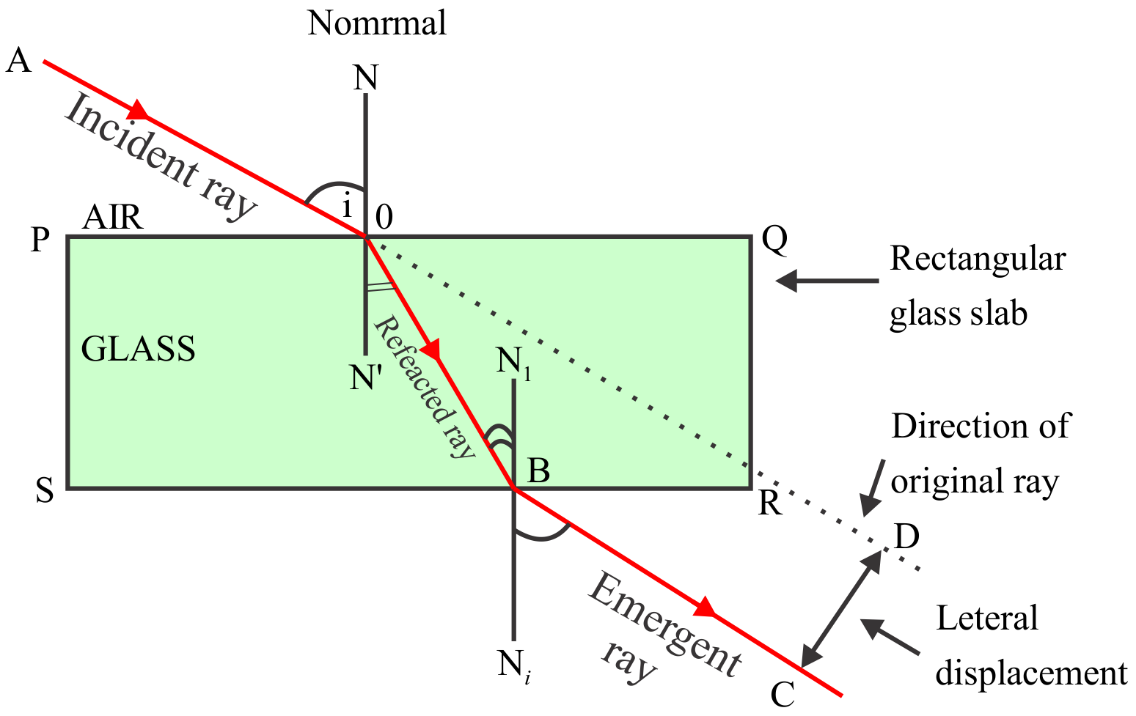
A student very cautiously traces the path of a ray through a glass slab for different values of the angle of incidence $\left( {\angle i} \right)$. He then measures the corresponding values of the angle of refraction $\left( {\angle r} \right)$ and the angle of emergence $\left( {\angle e} \right)$ for every value of the angle of incidence. On analyzing these measurements of angles, his conclusion would be
$\left( a \right)$ $\angle i > \angle r > \angle e$
$\left( b \right)$ $\angle i = \angle e > \angle r$
$\left( c \right)$ $\angle i,\angle r,\angle e$
$\left( d \right)$ $\angle i = \angle e,\angle r$
Answer
219k+ views
Hint Angle of incidence is the adequate angle of emergence and angle of incidence is bigger than the angle of refraction additionally angle of refraction is less than angle emergence. By using all the above concepts we can answer the question.
Complete Step by Step Solution We discovered, that once a ray of light passes from rarer medium to denser medium, it diverges toward the normal, and once this refracted lightweight emerges, then it goes away from the normal, once the incident and also the emerging medium is the same then the angle of incidence and also the angle of emerging perpetually are equal.

As the incident ray is parallel to the emerging ray so we will conclude that the angle of incidence is adequate the angle of emergence
And mathematically we can write it as,
$\angle i = \angle e$
And also the ray traveling from the rarer medium which is air, to the denser medium which is glass slab. The ray will slightly bend towards the normal after the refraction.
Thus we can say that the angle of refraction is smaller than the angle of incidence.
$\angle i > \angle r$
Therefore, $\angle i = \angle e > \angle r$ will be the correct option. That is an option$b$.
Note
It may be noted that this is, in general, true only if the normal at the point of incidence and the point of emergence are parallel to each other as in the case of rectangular slabs of the second medium. In the case of a prism, the conventional at the purpose of incidence isn't parallel to the conventional at the purpose of emergence. They are equal only for the angle of minimum deviation.
Complete Step by Step Solution We discovered, that once a ray of light passes from rarer medium to denser medium, it diverges toward the normal, and once this refracted lightweight emerges, then it goes away from the normal, once the incident and also the emerging medium is the same then the angle of incidence and also the angle of emerging perpetually are equal.

As the incident ray is parallel to the emerging ray so we will conclude that the angle of incidence is adequate the angle of emergence
And mathematically we can write it as,
$\angle i = \angle e$
And also the ray traveling from the rarer medium which is air, to the denser medium which is glass slab. The ray will slightly bend towards the normal after the refraction.
Thus we can say that the angle of refraction is smaller than the angle of incidence.
$\angle i > \angle r$
Therefore, $\angle i = \angle e > \angle r$ will be the correct option. That is an option$b$.
Note
It may be noted that this is, in general, true only if the normal at the point of incidence and the point of emergence are parallel to each other as in the case of rectangular slabs of the second medium. In the case of a prism, the conventional at the purpose of incidence isn't parallel to the conventional at the purpose of emergence. They are equal only for the angle of minimum deviation.
Recently Updated Pages
A square frame of side 10 cm and a long straight wire class 12 physics JEE_Main

The work done in slowly moving an electron of charge class 12 physics JEE_Main

Two identical charged spheres suspended from a common class 12 physics JEE_Main

According to Bohrs theory the timeaveraged magnetic class 12 physics JEE_Main

ill in the blanks Pure tungsten has A Low resistivity class 12 physics JEE_Main

The value of the resistor RS needed in the DC voltage class 12 physics JEE_Main

Trending doubts
JEE Main 2026: Application Form Open, Exam Dates, Syllabus, Eligibility & Question Papers

Derivation of Equation of Trajectory Explained for Students

Hybridisation in Chemistry – Concept, Types & Applications

Understanding the Angle of Deviation in a Prism

Understanding Collisions: Types and Examples for Students

Understanding Atomic Structure for Beginners

Other Pages
JEE Advanced Marks vs Ranks 2025: Understanding Category-wise Qualifying Marks and Previous Year Cut-offs

How to Convert a Galvanometer into an Ammeter or Voltmeter

Understanding Centrifugal Force in Physics

JEE Main Marking Scheme 2026- Paper-Wise Marks Distribution and Negative Marking Details

Degree of Dissociation: Meaning, Formula, Calculation & Uses

Understanding Electromagnetic Waves and Their Importance




